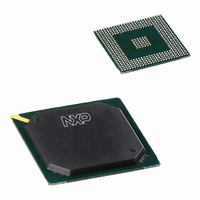PNX1500E/G,557 NXP Semiconductors, PNX1500E/G,557 Datasheet - Page 274

PNX1500E/G,557
Manufacturer Part Number
PNX1500E/G,557
Description
IC MEDIA PROC 240MHZ 456-BGA
Manufacturer
NXP Semiconductors
Specifications of PNX1500E/G,557
Applications
Multimedia
Core Processor
TriMedia
Controller Series
Nexperia
Interface
I²C, 2-Wire Serial
Number Of I /o
61
Voltage - Supply
1.14 V ~ 1.26 V
Operating Temperature
0°C ~ 85°C
Mounting Type
Surface Mount
Package / Case
456-BGA
Lead Free Status / RoHS Status
Lead free / RoHS Compliant
Program Memory Type
-
Ram Size
-
Lead Free Status / Rohs Status
Compliant
Other names
568-1296
935277746557
PNX1500E/G
935277746557
PNX1500E/G
- Current page: 274 of 828
- Download datasheet (8Mb)
Philips Semiconductors
Volume 1 of 1
PNX15XX_SER_3
Product data sheet
2.2.1 Timestamp Reference clock
2.2.2 Timestamp format
2.3 GPIO: The Signal Monitoring & Pattern Generation Modes
Event monitoring is commonly used for low frequency events (less than a 100 per
second) while signal monitoring can be used for more frequent events. Therefore the
timestamp units are shared with the Signal Monitoring logic,
The timestamp reference clock is based on a 34-bit counter running at 108 MHz.
However the frequency used for all timestamping in PNX15xx Series is 13.5 MHz
(i.e., 108 MHz/8) which gives a better than 75 ns event resolution, i.e. only the upper
32-bit of the counter is visible by software. The counter can be observed with the
TIME_CTR MMIO register.
The counter is reset by the PNX15xx Series system reset.
Any change (according to the monitored edge event) generates a 31-bit timestamp
and a 1 bit edge direction in a 32-bit word. The 1-bit direction indicator is a logic ‘1’ if
a rising edge has occurred and a logic ‘0’ if a falling edge has occurred. The direction
bit is the MSB of the 32-bit word generated. This is pictured in
Remark: The event timestamps can be written (per monitored signal) to a memory
buffer,
There are 4 FIFO queues available to perform signal monitoring or pattern generation
(mutually exclusive). Each FIFO queue can be programmed to operate in either of
these modes for a selected group of GPIO pins.
The FIFO has DMA capability to allow efficient CPU access to large event lists (in
opposite to the event monitoring described in
Figure 3:
•
•
An overrun error interrupt is generated whenever new data is received before the
DATA_VALID interrupt has been cleared. The old data is not overwritten, the new
data is lost. The overrun interrupt shares the same interrupt MMIO registers as
the VALID_DATA interrupt. The interrupt is enabled with INT_ENABLE4, cleared
through INT_CLEAR4 and consulted through INT_STATUS4 MMIO registers.
Upon a DATA_VALID interrupt the corresponding 32-bit TimeStamp Unit (TSU)
MMIO register is stable to be read by software when the relevant
DATA_VALID_[11:0] flag in the INT_STATUS4 MMIO register is raised. The TSU
register contains the timestamp information, a direction bit and a 31-bit
timestamp value, see
Section
32-bit Timestamp Format
Dir = 0 => falling edge
Dir = 1 => rising edge
Dir
2.3.1, or to a timestamp unit register, which is software readable.
31
Rev. 3 — 17 March 2006
30
31-bit timestamp
Section
2.2.2.
Chapter 8: General Purpose Input Output Pins
Section
© Koninklijke Philips Electronics N.V. 2006. All rights reserved.
2.2).
PNX15xx Series
Section
Figure
2.3.1.
0
3.
8-7
Related parts for PNX1500E/G,557
Image
Part Number
Description
Manufacturer
Datasheet
Request
R

Part Number:
Description:
Manufacturer:
NXP Semiconductors
Datasheet:
Part Number:
Description:
Digital Signal Processors & Controllers - DSP, DSC NEXPERIA MEDIA PROC 240MHZ
Manufacturer:
NXP Semiconductors
Part Number:
Description:
Digital Signal Processors & Controllers - DSP, DSC PNX1500, 240MHZ
Manufacturer:
NXP Semiconductors
Part Number:
Description:
NXP Semiconductors designed the LPC2420/2460 microcontroller around a 16-bit/32-bitARM7TDMI-S CPU core with real-time debug interfaces that include both JTAG andembedded trace
Manufacturer:
NXP Semiconductors
Datasheet:

Part Number:
Description:
NXP Semiconductors designed the LPC2458 microcontroller around a 16-bit/32-bitARM7TDMI-S CPU core with real-time debug interfaces that include both JTAG andembedded trace
Manufacturer:
NXP Semiconductors
Datasheet:
Part Number:
Description:
NXP Semiconductors designed the LPC2468 microcontroller around a 16-bit/32-bitARM7TDMI-S CPU core with real-time debug interfaces that include both JTAG andembedded trace
Manufacturer:
NXP Semiconductors
Datasheet:
Part Number:
Description:
NXP Semiconductors designed the LPC2470 microcontroller, powered by theARM7TDMI-S core, to be a highly integrated microcontroller for a wide range ofapplications that require advanced communications and high quality graphic displays
Manufacturer:
NXP Semiconductors
Datasheet:
Part Number:
Description:
NXP Semiconductors designed the LPC2478 microcontroller, powered by theARM7TDMI-S core, to be a highly integrated microcontroller for a wide range ofapplications that require advanced communications and high quality graphic displays
Manufacturer:
NXP Semiconductors
Datasheet:
Part Number:
Description:
The Philips Semiconductors XA (eXtended Architecture) family of 16-bit single-chip microcontrollers is powerful enough to easily handle the requirements of high performance embedded applications, yet inexpensive enough to compete in the market for hi
Manufacturer:
NXP Semiconductors
Datasheet:

Part Number:
Description:
The Philips Semiconductors XA (eXtended Architecture) family of 16-bit single-chip microcontrollers is powerful enough to easily handle the requirements of high performance embedded applications, yet inexpensive enough to compete in the market for hi
Manufacturer:
NXP Semiconductors
Datasheet:
Part Number:
Description:
The XA-S3 device is a member of Philips Semiconductors? XA(eXtended Architecture) family of high performance 16-bitsingle-chip microcontrollers
Manufacturer:
NXP Semiconductors
Datasheet:

Part Number:
Description:
The NXP BlueStreak LH75401/LH75411 family consists of two low-cost 16/32-bit System-on-Chip (SoC) devices
Manufacturer:
NXP Semiconductors
Datasheet:

Part Number:
Description:
The NXP LPC3130/3131 combine an 180 MHz ARM926EJ-S CPU core, high-speed USB2
Manufacturer:
NXP Semiconductors
Datasheet:

Part Number:
Description:
The NXP LPC3141 combine a 270 MHz ARM926EJ-S CPU core, High-speed USB 2
Manufacturer:
NXP Semiconductors

Part Number:
Description:
The NXP LPC3143 combine a 270 MHz ARM926EJ-S CPU core, High-speed USB 2
Manufacturer:
NXP Semiconductors










